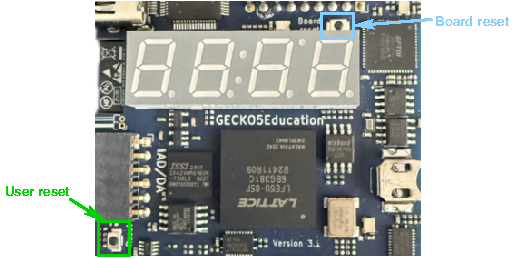Reset system
The GECKO5Education provides two means of resetting the system, namely:
A board reset. Using this reset will equal to the same behavior as removing and adding the board from/to your computer.
A user reset. This can be used to only reset your system that is mapped in your FPGA.

Note
The board reset you will normally never use. Only in combination with the ESP32-programming it can be usefull.
Using the user reset
The user reset is a button that has a pull-up and is connected to a clock input of the FPGA. It can of course also be used for another function as reset.
Note
The user reset is active-low. Meaning that activating it will deliver a logic 0. Otherwise it will produce a logic 1.
In this section you find a VHDL and Verilog top-level and the corresponding lpf-file that you can use to use the above described user reset button.
Important
Although VHDL is case-insensitive, the lpf-file is not. Meaning that the port-names in the top-level entity need to be copied exactly in the lpf-file.
An example for a VHDL top-level entity is shown below:
library ieee;
use ieee.std_logic_1164.all;
entity toplevel is
port ( nReset : in std_logic;
...);
end toplevel;
An example for a Verilog top-level is shown below:
module toplevel (
input wire nReset,
...);
...
endmodule
To connect nReset to the correct location, following lines must be added to the lpf-file:
LOCATE COMP "nReset" SITE "G1";
IOBUF PORT "nReset" PULLMODE=NONE IO_TYPE=LVCMOS33;
Important
Note the case-sensitivity of the lpf-file.
The tools require exactly one lpf-file, hence all assignments you use need to be in a single lpf-file.
Summary
Below a table with all required information for the user reset button:
Name : |
FPGA pin: |
Activity: |
IO_TYPE: |
Pull-up/down: |
|---|---|---|---|---|
User Reset |
G1 |
Active-low |
LVCMOS33 |
NONE |